Sysgration AM7500 Wireless Mouse User Manual 3
Sysgration Ltd. Wireless Mouse 3
User Manual
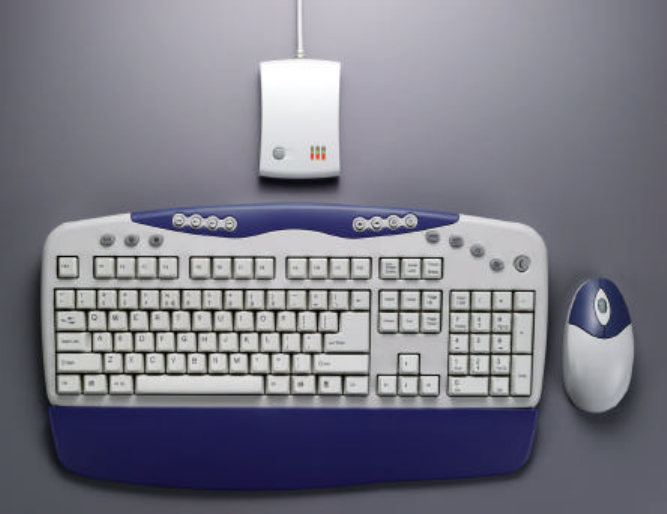
Wireless RF Keyboard & Mouse
P
PR
RE
EF
FA
AC
CE
E
R
R&
&T
TT
TE
E
C
Co
om
mp
pl
li
ia
an
nc
ce
e
S
St
ta
at
te
em
me
en
nt
t
This equipment complies with all the requirements of the DIRECTIVE 1999/5/EC OF THE
EUROPEAN PARLIAMENT AND THE COUNCIL OF 9 March 1999 on radio equipment and
telecommunication terminal equipment and the mutual recognition of their conformity
(R&TTE).
S
Sa
af
fe
et
ty
y
This equipment is designed with the utmost care for the safety of those who install and use it.
However, special attention must be paid to the dangers of electric shock and static electricity
when working with electrical equipment. All guidelines of this manual and of the computer
manufacturer must therefore be allowed at all times to ensure the safe use of the equipment.
F
Fe
ed
de
er
ra
al
l
C
Co
om
mm
mu
un
ni
ic
ca
at
ti
io
on
ns
s
C
Co
om
mm
mi
is
ss
si
io
on
n
R
Ra
ad
di
io
o
(
(F
FC
CC
C)
)
S
St
ta
at
te
em
me
en
nt
t
This equipment has been tested and found to comply with the limits for a Class B digital de-
vice, pursuant to Part 15 of the FCC Rules. These limits are designed to provide reasonable
protection against harmful interference in a residential installation. This equipment generates,
uses, and can radiate radio frequency energy and if not installed and used in accordance with
the instruction manual may cause harmful interference to radio communications. However,
there is no guarantee that interference will not occur in a particular installation. If this equip-
ment does cause harmful interference to radio or television reception, which can be
determined by turning the equipment off and on, the user is encouraged to try to correct the
interference by one or more of the following measures:
− Reorient or relocate the receiving antenna.
− Increase the separation between the equipment and receiver.
− Connect the equipment into an outlet on a circuit different from that to which the
receiver is connected.
− Consult the dealer or an experienced radio TV technician for help.
T
Ta
ab
bl
le
e
o
of
f
C
Co
on
nt
te
en
nt
ts
s
INTRODUCTION................................................................................................................1
PACKAGE CONTENTS ...........................................................................................................2
SYSTEM REQUIREMENTS......................................................................................................2
FEATURES ...........................................................................................................................2
MAINBOARD AND MOUSE COMPONENTS................................................................3
WIRELESS RF KEYBOARD ...................................................................................................3
WIRELESS RF MOUSE .........................................................................................................4
RF RECEIVER ......................................................................................................................4
INSERTING BATTERIES..................................................................................................5
MOUSE................................................................................................................................5
KEYBOARD..........................................................................................................................6
SETTING UP YOUR KEYBOARD AND MOUSE..........................................................7
INSTALLING THE SOFTWARE......................................................................................9
MOUSE................................................................................................................................9
KEYBOARD........................................................................................................................11
USING THE SOFTWARE................................................................................................15
IWARE MOUSE ..................................................................................................................15
MULTIMEDIA KEYBOARD ..................................................................................................17
TROUBLESHOOTING.....................................................................................................20
A WORD ABOUT ERGONOMICS.................................................................................22
SPECIFICATIONS............................................................................................................23
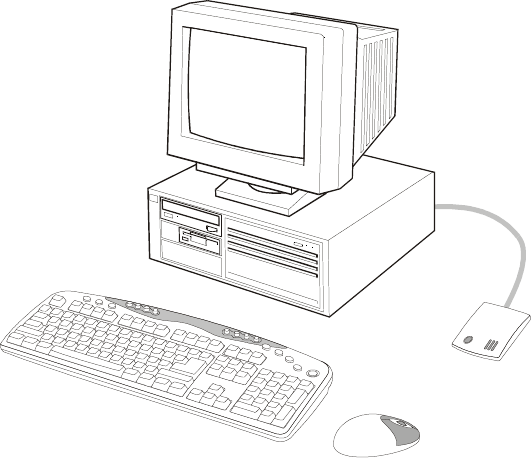
1
I
In
nt
tr
ro
od
du
uc
ct
ti
io
on
n
Congratulations on your purchase of the Wireless RF Keyboard & Mouse, which
combines an innovative ergonomic design with all the features and convenience of
wireless technology:
Wireless RF Keyboard
Wireless RF Mouse
RF Receiver
The Wireless RF Keyboard has advanced multimedia features that enable you to
play audio CDs, VCDs, DVDs, and MPEG files. You can use the keyboard hot keys
to raise, lower and mute audio.
Other hot keys let you open your default Web browser and refresh Web pages,
browse forward and backwards, open a search page, and send e-mail. There are
also hot keys for launching the Windows calculator and entering power savings
mode.
The bundled software further enhances your keyboard by supplying an onscreen
display (OSD) and onscreen menus to control audio and Web functions.
The Wireless RF Mouse has a scroll wheel/middle button that can be assigned
various functions such as Web page or word processing software scrolling, or
launching applications such as Windows Explorer.
2
P
Pa
ac
ck
ka
ag
ge
e
C
Co
on
nt
te
en
nt
ts
s
After you have unpacked the Wireless RF Keyboard & Mouse, check the contents
to make sure the following items are included.
• One Wireless RF Mouse
• One Wireless RF Keyboard
• One RF receiver
• Two AAA alkaline batteries (for the mouse)
• Two AA alkaline batteries (for the keyboard)
• This quick guide
If any of the above items are missing or appear damaged, contact your dealer im-
mediately. Do not throw the shipping carton away in case you need to ship your
Wireless RF Keyboard & Mouse.
S
Sy
ys
st
te
em
m
R
Re
eq
qu
ui
ir
re
em
me
en
nt
ts
s
To use the mouse software and the hot keys on your multimedia keyboard, you
need the following:
• Windows ME/2000/98/95/NT 4.0 or later
• PS/2 mouse and keyboard ports
• Sound Blaster compatible sound card (for CD/VCD/DVD, and MPEG operation)
• CD-ROM drive (for software installation and CD/VCD operation)
• DVD-ROM drive (for DVD operation)
F
Fe
ea
at
tu
ur
re
es
s
• Wireless radio frequency (RF) technology
• Scroll wheel mouse enables scrolling in Web pages and text editors
• Onscreen display (OSD) provides status information
• Keyboard multimedia and Web hot keys provide convenient access to of-
ten used commands
• Plug and Play compliant
• Compatible with Windows ME/2000/98/95/NT4.0
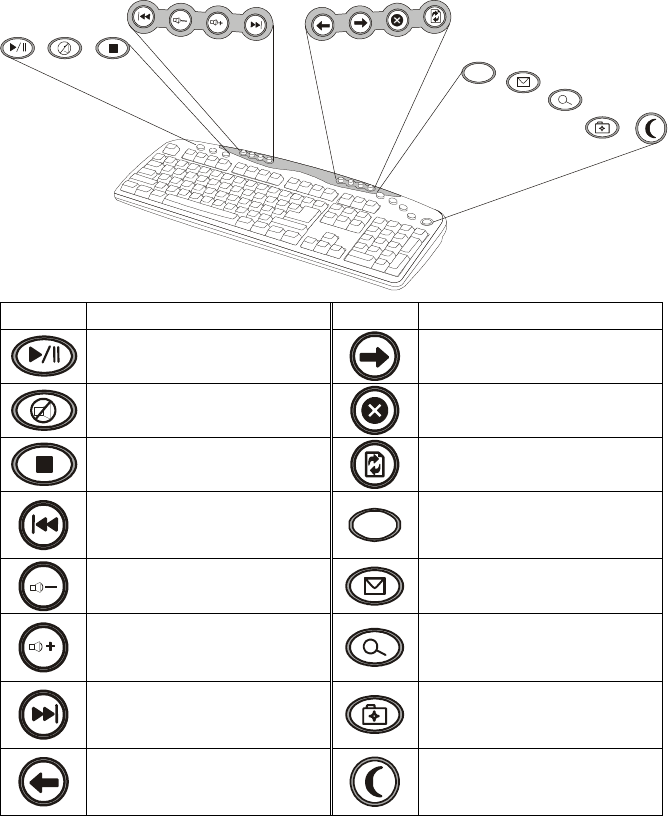
3
M
Ma
ai
in
nb
bo
oa
ar
rd
d
a
an
nd
d
M
Mo
ou
us
se
e
C
Co
om
mp
po
on
ne
en
nt
ts
s
W
Wi
ir
re
el
le
es
ss
s
R
RF
F
K
Ke
ey
yb
bo
oa
ar
rd
d
The following illustration shows the Wireless RF Keyboard and hot keys:
WWW
Button Function Button Function
Play/Pause: plays or
pauses a CD/DVD/VCD Forward: goes to the next
page in your Web browser
Mute: turns off the audio
output Stop: stops loading a Web
page
Stop: stops playing a
CD/DVD/VCD Refresh: reloads the Web
page
Next Track: searches back-
ward through tracks on a
CD/DVD/VCD
WWW
World Wide Web: opens
your default Web browser
Volume Down: decreases
audio volume E-mail: launches the default
e-mail application
Volume Up: increases audio
volume Search: opens a search
window in Netscape or
Windows IE
Previous Track: searches
forwards through tracks on a
CD/DVD/VCD
My Favorite: opens the IE
favorites folder, or the Net-
scape bookmarks folder
Back: goes to the previous
page in your Web browser Suspend: enters the com-
puter into power saving
mode
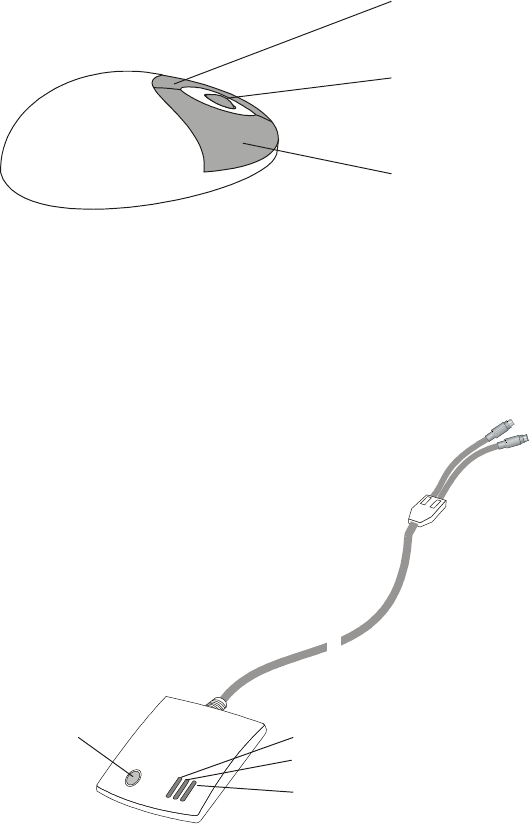
4
W
Wi
ir
re
el
le
es
ss
s
R
RF
F
M
Mo
ou
us
se
e
The following illustration shows the RF mouse components:
Left button
Scroll wheel/middle button
Right button
R
RF
F
R
Re
ec
ce
ei
iv
ve
er
r
The following illustration shows the RF receiver components:
Num Lock indicator
Caps Lock indicator
Scroll Lock indicator
Mouse/keyboard
connect button
PS/2 keyboard
connector (purple)
PS/2 mouse
connector (green)
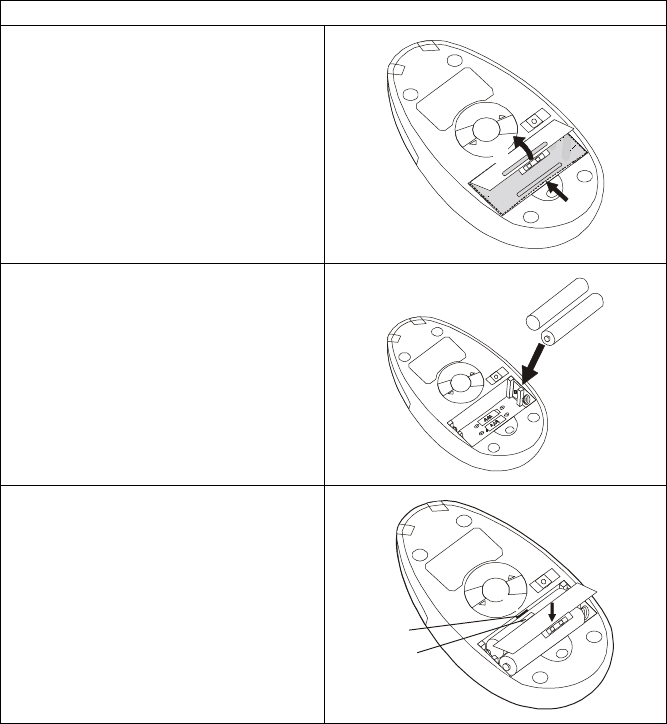
5
I
In
ns
se
er
rt
ti
in
ng
g
B
Ba
at
tt
te
er
ri
ie
es
s
The keyboard and mouse both require batteries to operate. The mouse uses two
AAA batteries and the keyboard uses two AA batteries. Refer to the following in-
structions and illustrations for inserting the batteries:
M
Mo
ou
us
se
e
1. Turn the mouse over.
2. Open the battery compartment.
Press the edge (A) with your
thumb and pull up (B).
A
B
3. Insert two AAA batteries into the
compartment. Ensure that you
orient the batteries according to
the polarity markings inside the
battery compartment.
4. Replace the battery compart-
ment cover. Insert the tab into
the slot (A) and flip the cover into
place (B).
B
A
Slot
Tab
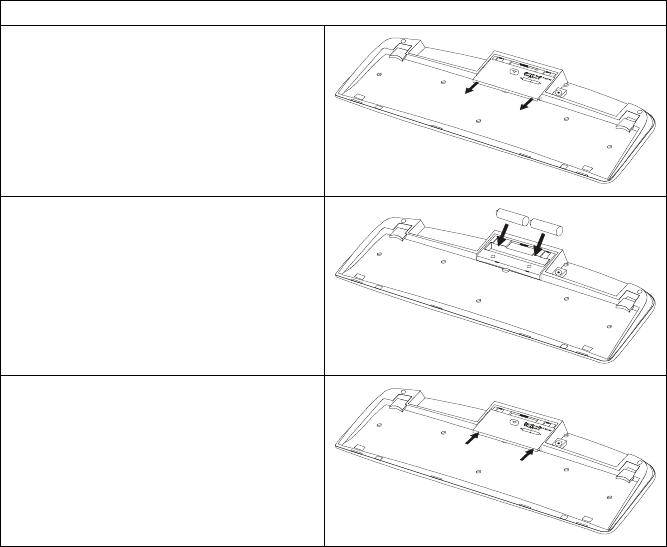
6
K
Ke
ey
yb
bo
oa
ar
rd
d
1. Turn the keyboard over.
2. Open the battery compartment.
Slide the cover in the direction of
the arrows.
3. Insert two AA batteries into the
compartment. Ensure that you
orient the batteries according to
the polarity markings inside the
battery compartment.
4. Replace the battery compart-
ment cover.
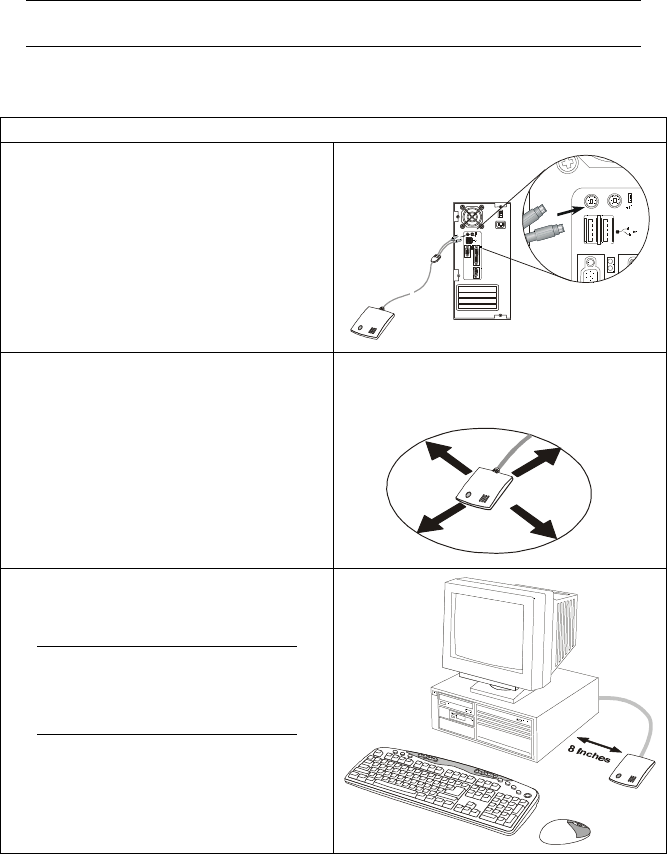
7
S
Se
et
tt
ti
in
ng
g
u
up
p
Y
Yo
ou
ur
r
K
Ke
ey
yb
bo
oa
ar
rd
d
a
an
nd
d
M
Mo
ou
us
se
e
Your RF keyboard and mouse connect to the PS/2 keyboard and mouse ports on
your computer.
Note! Insert the keyboard and mouse batteries before setting up the keyboard and
mouse. Refer to the previous section.
Refer to the following instructions and illustrations to connect the keyboard and
mouse to your PC:
1. Turn off your computer.
2. Plug the purple PS/2 connector
on the RF receiver cable into the
PS/2 keyboard port on your com-
puter.
3. Plug the green PS/2 connector on
the RF receiver cable into the
PS/2 mouse port on your com-
puter.
4. Place the RF receiver in a good
location.
Place the receiver at least
8 inches (20 cm) from electrical
devices such as the computer
or monitor.
5. Place the keyboard and the
mouse in the proper location for
your computer.
Note! Refer to the section on er-
gonomics later in the quick guide
for more information on setting
up your workstation.
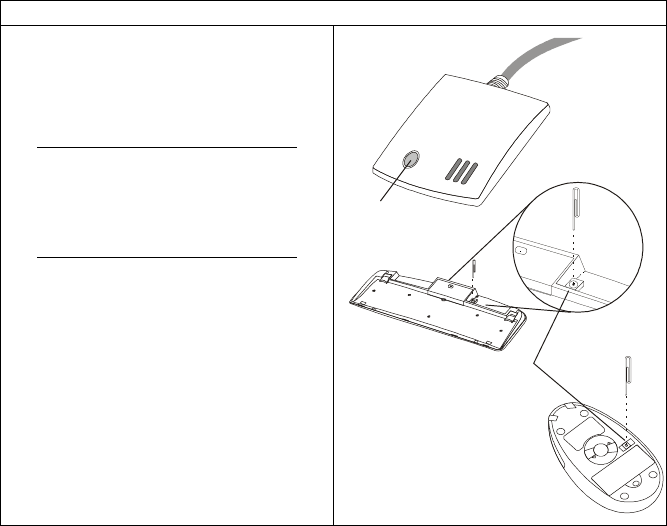
8
6. Turn on the computer.
7. Press the RF receiver connect
button (A), and then use a pen tip
or bent paper clip to press the
keyboard connect switch (B) and
the mouse connect switch (C).
Note! Repeat Step 7 when con-
necting the Wireless RF
Keyboard & Mouse for the first
time and after replacing the bat-
teries.
A
B
C
Receiver
connect button
Connect switches
Ensure that the mouse and keyboard are working. If they do not respond to mouse
movement or keystrokes, repeat Step 7 to ensure that a connection has been
made. If they still are not working, refer to the Troubleshooting section at the end of
this guide.
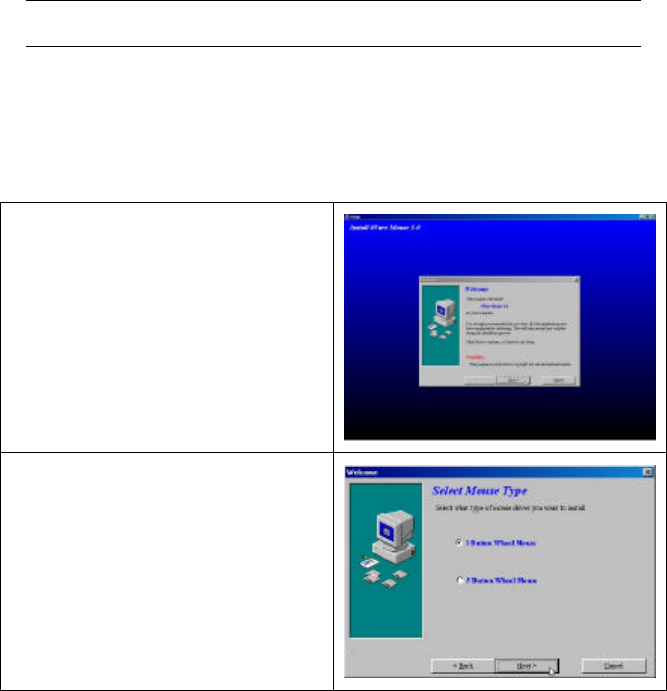
9
I
In
ns
st
ta
al
ll
li
in
ng
g
t
th
he
e
S
So
of
ft
tw
wa
ar
re
e
The RF mouse and multimedia keyboard come with software to enhance their
function. The software is located on the bundled CD.
Note! Connect your Wireless RF Keyboard & Mouse before installing the soft-
ware. Refer to the previous section.
Insert the software CD into the CD-ROM drive. The autoinstallation screen appears.
A menu provides you with the option of installing the mouse and keyboard.
Follow these instructions to install the keyboard and mouse software:
M
Mo
ou
us
se
e
1. From the software CD install
menu, click Install Mouse. The
iWare mouse installation program
starts. Click Next.
2. Select “3 Button Wheel Mouse,”
and click Next.
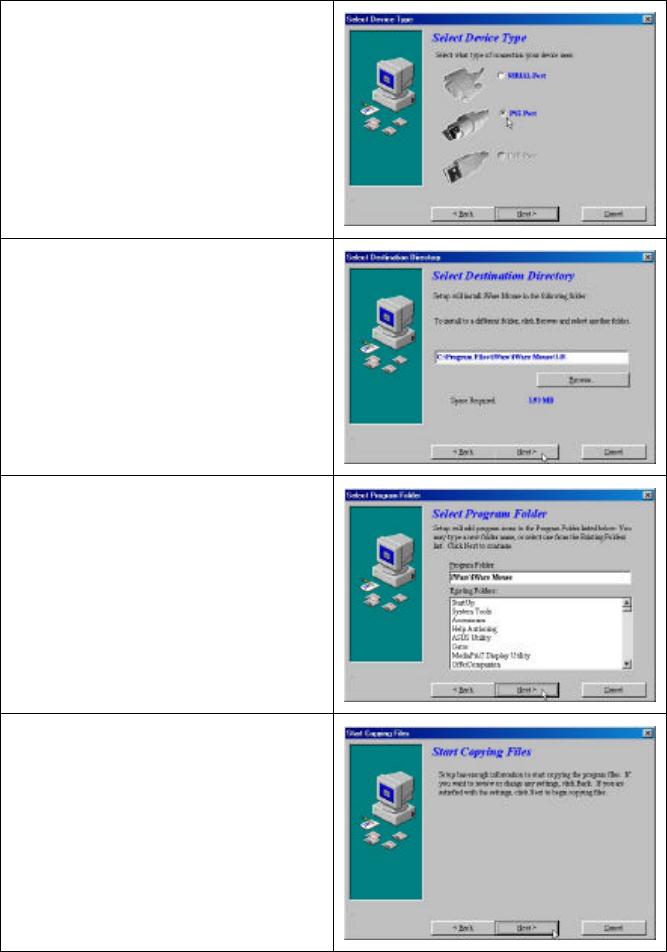
10
3. Select “PS2 Port” and click Next.
4. Click Next to accept the default
directory or browse to the desired
directory.
5. Click Next to accept the default
folder or type a new folder name.
6. Click Next to start copying files to
your computer.
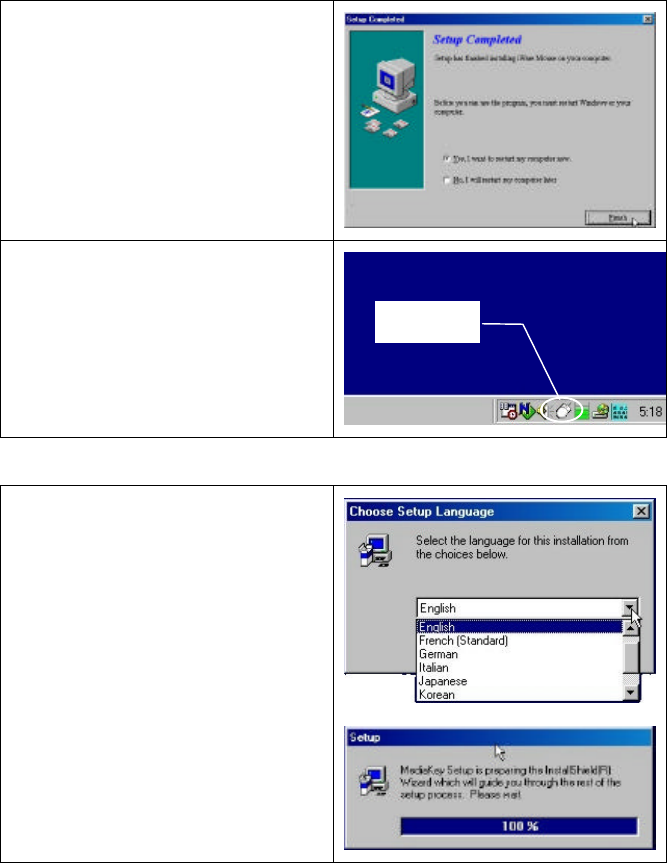
11
7. Click Finish to complete the in-
stallation.
When the computer has restarted, an
iWare mouse icon appears in the
taskbar.
K
Ke
ey
yb
bo
oa
ar
rd
d
1. From the software CD install
menu, click Install Keyboard. The
keyboard installation program
starts and you are prompted to
choose a setup language. Choose
your language and click Next.
The MediaKey Setup Wizard be-
gins.
iWare mouse
icon
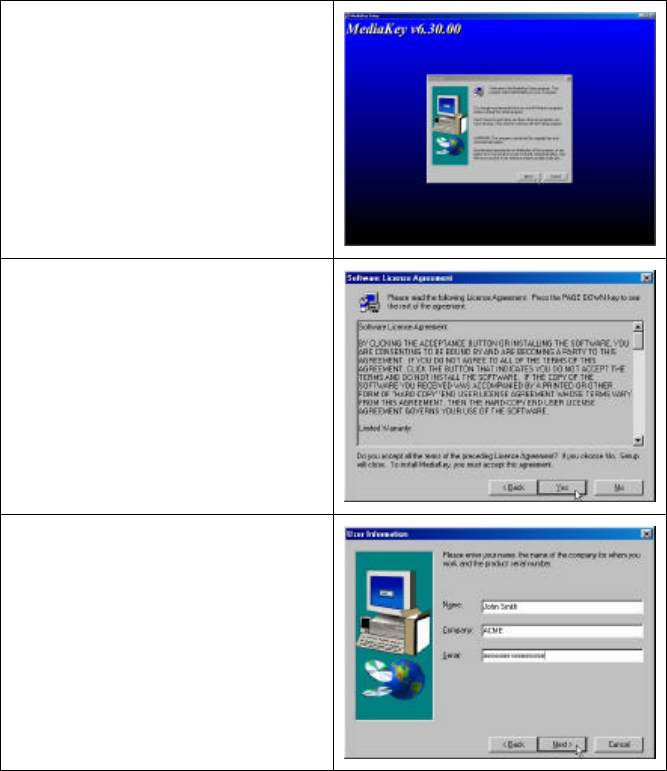
12
2. Click Next to continue the setup
program.
3. Read the Software License
Agreement and click Yes.
4. Enter your name, company name
if desired, and your serial number.
The serial number is located on
the software CD case. Click Next.
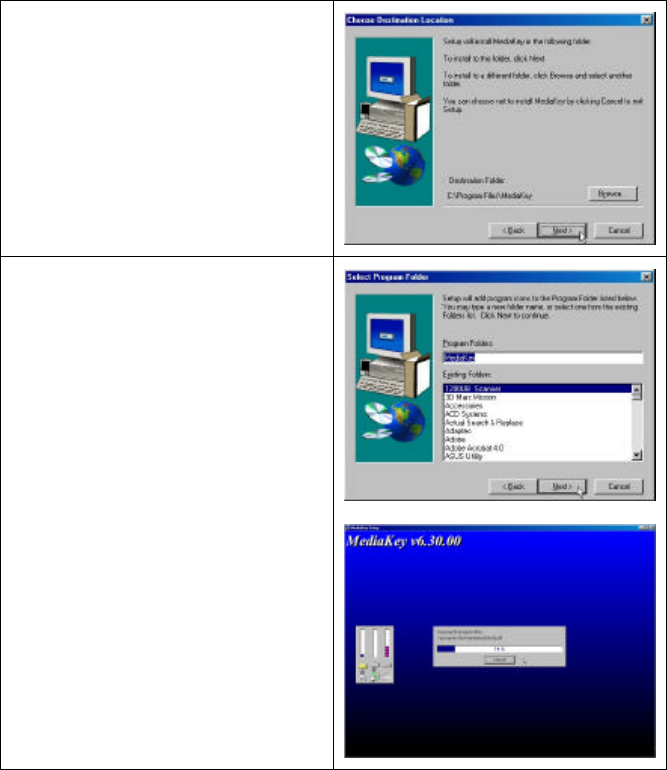
13
5. Click Next to accept the default
location or browse to a new loca-
tion.
6. Click Next to accept the default
folder or type a new folder name.
The setup program copies files to
the computer.
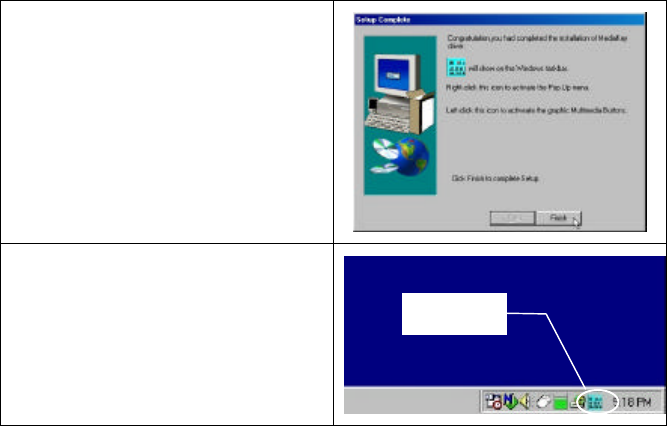
14
7. Click Finish to complete the in-
stallation.
When the setup program has finished
installing the multimedia software, a
MediaKey icon appears in the taskbar. MediaKey
icon
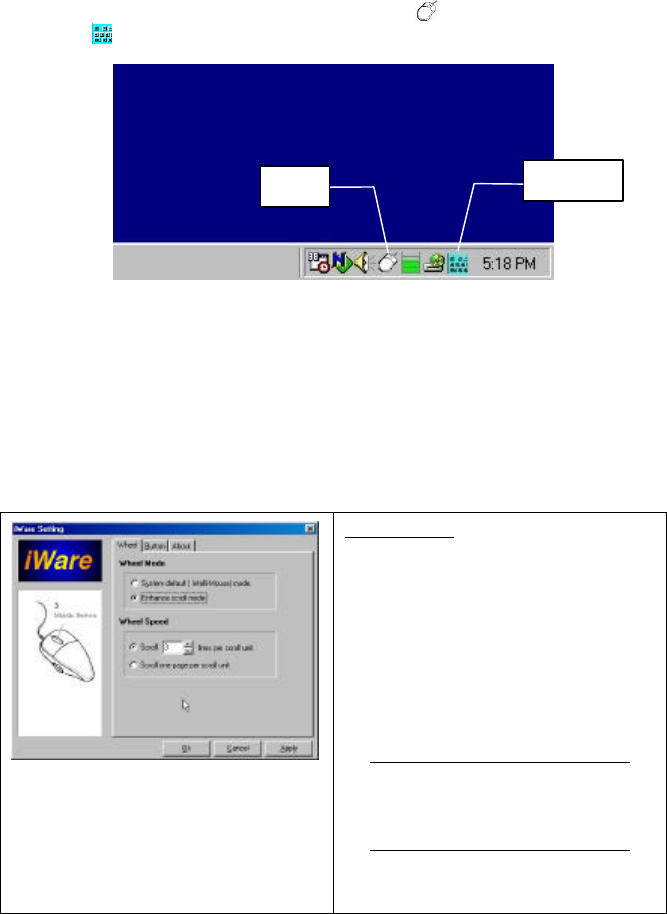
15
U
Us
si
in
ng
g
t
th
he
e
S
So
of
ft
tw
wa
ar
re
e
After your computer restarts, the iWare Mouse icon and the Multimedia Key-
board icon appear at the lower right side of your screen in the taskbar:
The following sections briefly describe the iWare Mouse and Multimedia Keyboard
software. For detailed information on the Multimedia Keyboard software, refer to
the Multimedia Keyboard online help.
i
iW
Wa
ar
re
e
M
Mo
ou
us
se
e
Double-click the iWare Mouse icon in the taskbar to open the iWare Mouse Setting
screen. The following table describes the iWare Settings:
Wheel Mode
These two items define the operation
of the scroll wheel:
• System default (Intelli-Mouse)
mode: this option sets the wheel
scrolling function as Microsoft’s
Intelli-Mouse standard.
• Enhance scroll mode: enables
enhanced scroll mode.
Note! Experiment with these two
modes; after some practice,
choose the mode to best suit your
work habits.
iWare
Mouse
Multimedia
Keyboard
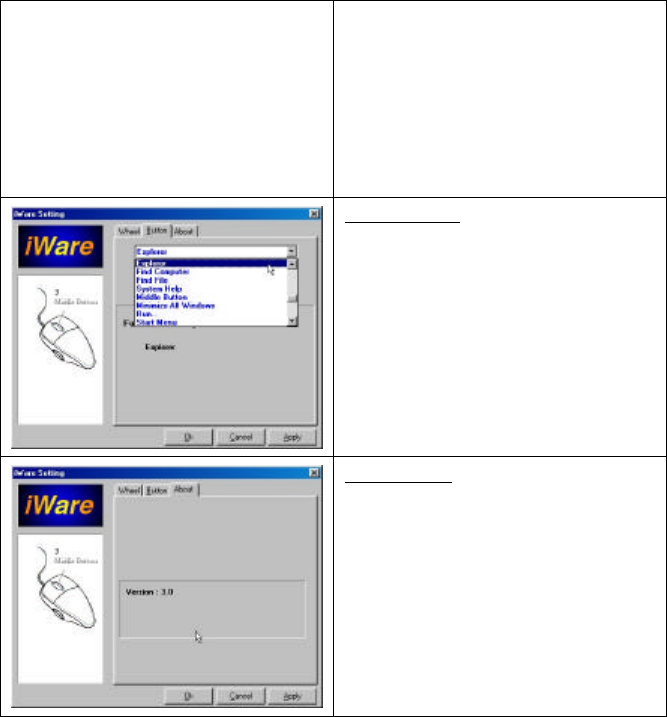
16
Wheel Speed
These items enable you to set how
fast the page scrolls on the screen:
• Scroll # lines per scroll unit:
sets the number of text lines that
the page will scroll.
• Scroll one page per scroll unit:
sets the screen to scroll one
complete page at a time.
Enables you to set the middle button
function. Choose the function from the
drop-down list.
Provides the iWare software version.
Refer to this screen when updating the
software to ensure that you have the
most recent version.
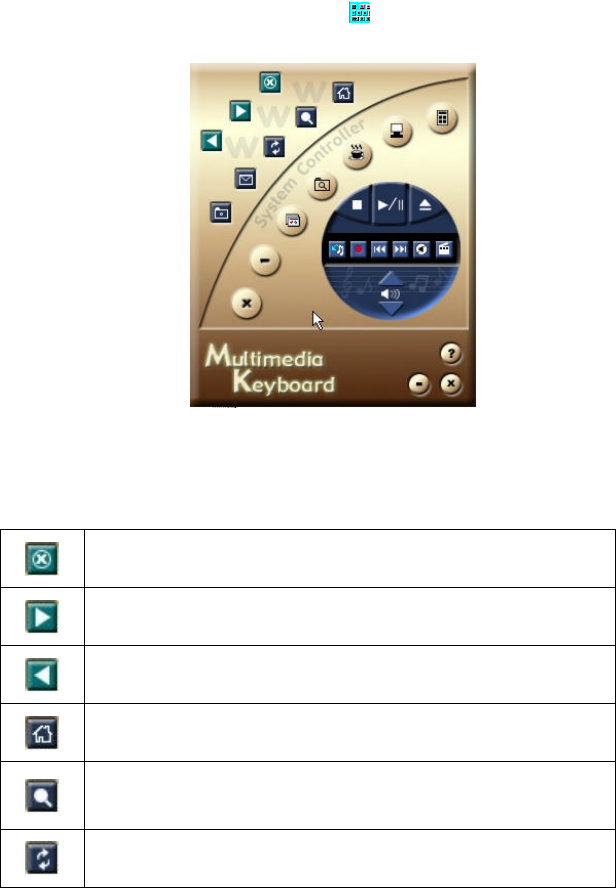
17
M
Mu
ul
lt
ti
im
me
ed
di
ia
a
K
Ke
ey
yb
bo
oa
ar
rd
d
Double-click the Multimedia Keyboard icon in the taskbar to open the Multime-
dia Keyboard utility:
The following table briefly describes the button functions:
Web Browser and File Functions
WWW Stop: click this button to stop downloading the current
Web page.
WWW Forward: click this button to go to the next Web page.
WWW Back: click this button to go to the previous Web page.
WWW Home: click this button to launch the default Internet
browser application and go to the default home page.
WWW Search: in IE 4.X and higher, clicking this button opens
a search window. In Netscape 4.X and higher, clicking this
button goes to the default search Web site.
WWW Refresh: click this button to reload the current Web
page.
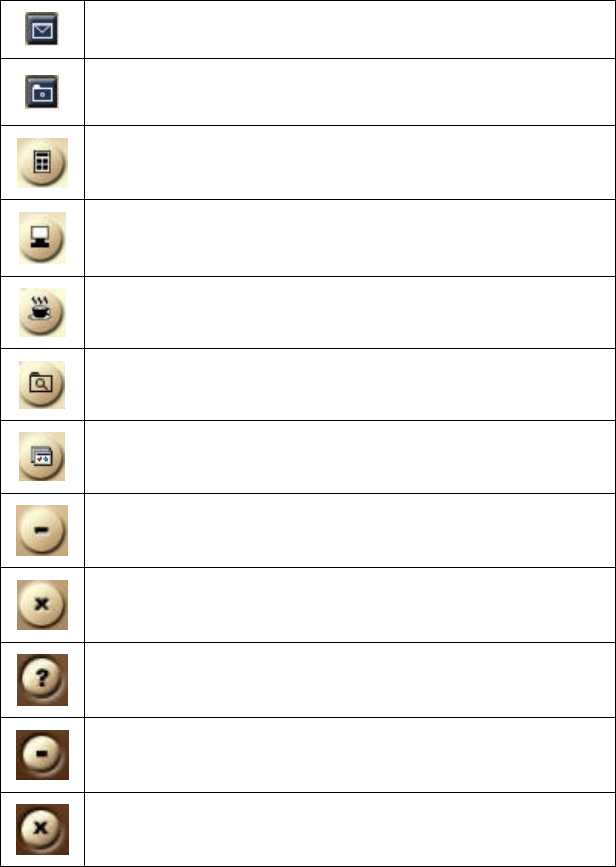
18
E-mail: click this button to launch the default mail application.
WWW Favorite: in IE 4.X and higher, clicking this button opens
My Favorites. In Netscape 4.X and higher, clicking this button
opens a Bookmark Window.
Calculator: click this button to open and close the Windows
calculator.
My Computer: click this button to open a My Computer win-
dow.
Screen Saver: click this button to launch the default screen
saver.
File Explorer: click this button to open a file explorer window.
Switch: click this button to switch between different application
windows.
Minimize Window: click this button to minimize the current
window.
Close Window: click this button to close the current window.
Help: click this button to launch the Multimedia Keyboard help
file.
Minimize: click this button to send the Multimedia Keyboard
Window to the task bar.
Close: click this button to close the Multimedia Keyboard
screen.
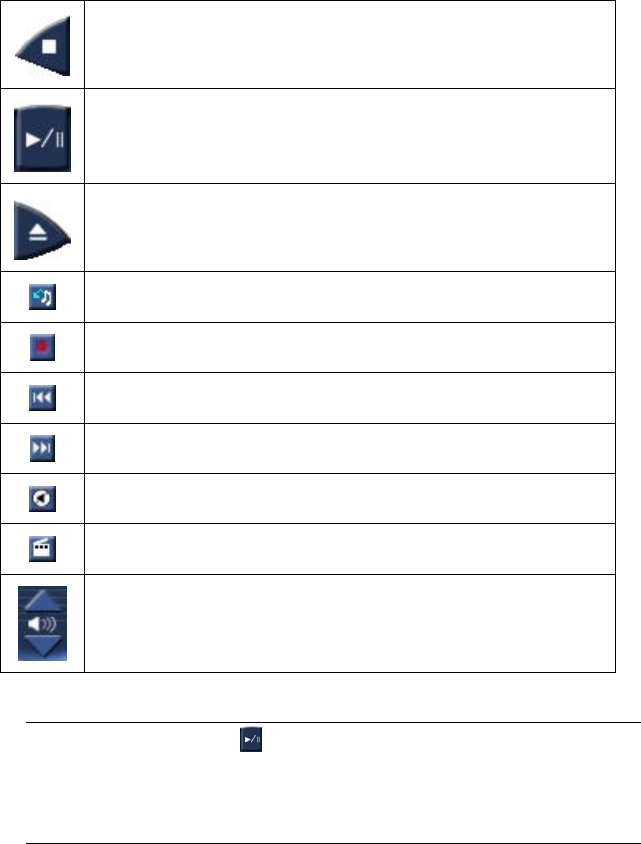
19
Multimedia Key Functions
CD Stop: click this button to stop playing a CD/DVD/VCD.
Play/Pause: click this button to play or pause a CD/DVD/VCD.
Eject: click this button to eject a CD/DVD/VCD.
Rewind: click this button to search backward through a
CD/DVD/VCD.
Record: click this button to launch the Microsoft Recorder.
Pre Track: click this button to go to the previous track on a
CD/DVD/VCD.
Next Track: click this button to go to the next track on a
CD/DVD/VCD.
Mute: click this button to turn off the audio.
Playlist: click this button to manage your playlists.
Volume Up/Down: click these buttons to raise and lower the
volume.
Note! When the play button is clicked, the application automatically detects
the type of media in the CD-ROM drive (AVI, MPEG, MOV, or audio) and be-
gins playing the media. If an audio or video CD is not detected, a dialog box
opens to help you select the file to play.
If two CD-ROM drives are installed on the computer, the default drive is selected.

20
T
Tr
ro
ou
ub
bl
le
es
sh
ho
oo
ot
ti
in
ng
g
Wireless RF Keyboard & Mouse not detected
If the keyboard and mouse don’t respond to activity, follow these steps:
1. Ensure that the receiver cable is properly connected to the PS/2 mouse
and keyboard ports (refer to Setting up Your Keyboard and Mouse on
page 7). Ensure that the purple connector is connected to the keyboard
port, and the green connector is connected to the mouse port.
2. Ensure that the batteries have been installed correctly (refer to Inserting
Batteries page 5).
3. Ensure that there are no IRQ or I/O address conflicts. Refer to your op-
erating system user’s manual for information on resolving IRQ and I/O
address conflicts.
4. Ensure that you have established a connection between the RF receiver
and the keyboard/mouse (refer to Setting up Your Keyboard and Mouse
on page 7).
Wireless RF Keyboard & Mouse don’t work after changing batteries
If the keyboard and mouse don’t respond to activity after replacing the batteries,
follow these steps:
1. Ensure that the batteries have been installed correctly (refer to Inserting
Batteries page 5).
2. Ensure that the batteries are not discharged.
3. Ensure that you have established a connection between the RF receiver
and the keyboard/mouse (refer to Setting up Your Keyboard and Mouse
on page 7).
Cursor doesn’t move properly on the screen
If the cursor doesn’t move or the motion is erratic, follow these steps:
1. Ensure that you have established a connection between the RF receiver
and the keyboard/mouse (refer to Setting up Your Keyboard and Mouse
on page 7).
2. Change the position of the RF receiver. There should be a distance of at
least 8 inches (20 cm) between the receiver and any electrical appliance
(such as speakers, the monitor, or the computer).
3. Ensure that the mouse batteries are not discharged. If they are dis-
charged replace them (refer to Inserting Batteries page 5).

21
4. Clean the mouse ball and rollers.
a. Remove the retainer ring on the bottom of the mouse (press in the
direction of the arrow on the retainer-ring cover).
b. Remove the ball from the compartment.
c. Wipe the ball with a clean, lint-free cloth.
d. Blow into the ball compartment to dislodge dust and lint.
e. If the rollers inside the ball compartment have dirt on them, clean
the rollers using a cotton swab moistened with isopropyl rubbing
alcohol.
f. Replace the ball and retainer ring.
After pressing the sleep button, the computer doesn’t wake up
After pressing the sleep button to place the computer into suspend mode, the
computer doesn’t wake up after pressing another key (other than the sleep button).
There may be a problem with power management. Some systems are unable to
wake up after being placed into suspend mode.
Follow these steps to fix this problem:
1. Refer to your computer hardware documentation regarding power-
management operation.
2. Ensure that the power-management settings for your operating system
are correct, as described in Windows Help.
22
A
A
W
Wo
or
rd
d
a
ab
bo
ou
ut
t
E
Er
rg
go
on
no
om
mi
ic
cs
s
Ergonomics is the study of how people with their different physical characteristics
and ways of functioning relate to their working environment (the furnishings and
machines they use). The goal of Ergonomics is to incorporate comfort, efficiency,
and safety into the design of keyboards, computer desks, chairs, and other items in
an effort to prevent physical discomfort and health problems in the working envi-
ronment.
If your budget permits, buy ergonomically designed furniture such as chairs,
shelves, and desks that fit your physical characteristics and work methods.
You can create an ergonomically improved workstation without spending much
money. Following are a few tips to help you work effectively without a lot of physi-
cal discomfort:
• Keep your forearms, wrists, and hands in a relaxed position, with your el-
bows at your side.
• Position the keyboard and mouse so that you do not have to reach for
them.
• Don’t strike the keys too hard; type with a soft touch.
• Keep your thighs parallel to the floor and your feet flat on the floor or on a
footrest.
• Use a chair that provides good back support.
• Try to place the monitor so that there is little glare from the sun on the
monitor.
• Walk around the room every hour.
• Every half-hour look away from the computer screen for a few minutes.
• Vary your tasks throughout the day.
• Avoid resting your wrists on sharp edges.

23
S
Sp
pe
ec
ci
if
fi
ic
ca
at
ti
io
on
ns
s
RF Mouse
Working frequency 27.045 MHz
Channel number 1
Channel spacing —
Modulation method FSK
Current dissipation < 10 mA
Standby mode current < 3 mA
Sleeping mode current <0.5 mA
Transmitting angle 360°
Working distance up to 1.5 meters
RF Keyboard
Working frequency 27.145 MHz
Channel number 1
Channel spacing —
Modulation method FSK
Current dissipation < 6 mA
Standby mode current —
Sleeping mode current <0.5 mA
Transmitting angle 360°
Working distance up to 1.5 meters
RF Receiver
Channel number 2
Channel spacing 100 KHz
Current dissipation < 65 mA
Working distance up to 1.5 meters